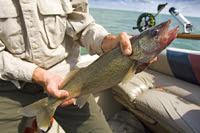Hints on Targeting Michigan Walleye
Category: press release
Aug 11th, 2014 by OutdoorsFIRST
Modified Aug 11th, 2014 at 12:00 AM
Most anglers targeting walleye know that catching them in the spring is much easier than catching them during the warmer summertime months. In most Michigan lakes walleye in the summer typically seek cooler, deeper and darker waters while typically feeding in the shallow waters only at night. Because of some physiological properties of walleye, their sensitivity to bright light typically results in avoidance of shallow waters during day light periods.

Anglers in the summer time months typically target walleye during the evening and morning time “low-light” periods. Targeted water depths will vary between lakes, but most anglers seek drop-offs where walleye will typically move up to feed in the shallow waters during the evening through morning hours. My experience fishing walleye in this fashion is usually successful by using a leech or minnow on a floating jighead weighted with a small splitshot sinker (or two). Anchoring at the drop-off or using a slow drift has been the most productive for me.
Other anglers may want to troll artificial lures or crawler harnesses along the deeper side of the contour lines in order to cover more area in a shorter time period. My grandfather always used to say, “Once you find them, you need to stay on, em.” I think there is a lot of truth to that.
Walleye fishing is sometimes a frustrating activity due to some long waiting periods between catches and finding the perfect conditions. However, once you get a bite it typically signifies something special and hopefully a memorable experience with family and friends.
This tip was written by Cory Kovacs, Fisheries Management Biologist in Newberry
 |
Most anglers targeting walleye know that catching them in the spring is much easier than catching them during the warmer summertime months. In most Michigan lakes walleye in the summer typically seek cooler, deeper and darker waters while typically feeding in the shallow waters only at night. Because of some physiological properties of walleye, their sensitivity to bright light typically results in avoidance of shallow waters during day light periods.
Anglers in the summer time months typically target walleye during the evening and morning time “low-light” periods. Targeted water depths will vary between lakes, but most anglers seek drop-offs where walleye will typically move up to feed in the shallow waters during the evening through morning hours. My experience fishing walleye in this fashion is usually successful by using a leech or minnow on a floating jighead weighted with a small splitshot sinker (or two). Anchoring at the drop-off or using a slow drift has been the most productive for me.
Other anglers may want to troll artificial lures or crawler harnesses along the deeper side of the contour lines in order to cover more area in a shorter time period. My grandfather always used to say, “Once you find them, you need to stay on, em.” I think there is a lot of truth to that.
Walleye fishing is sometimes a frustrating activity due to some long waiting periods between catches and finding the perfect conditions. However, once you get a bite it typically signifies something special and hopefully a memorable experience with family and friends.
This tip was written by Cory Kovacs, Fisheries Management Biologist in Newberry
– See more at: http://www.thefishingwire.com/story/325666#sthash.dtxvMyCb.dpuf